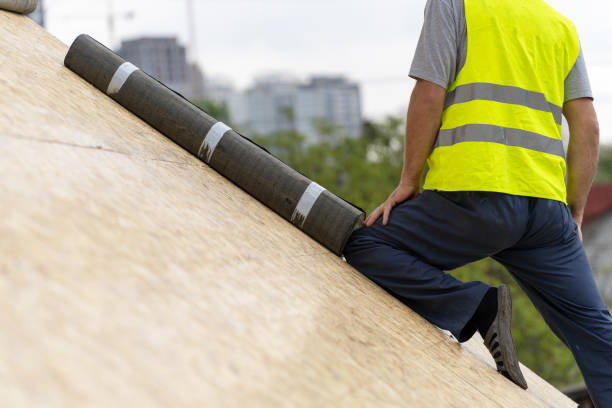
If your roof has recently sustained damage and you’re considering a full replacement, the cost of traditional roofing materials can be daunting. But don’t worry—there’s an alternative that could save you money: roll roofing.
Roll roofing is a simple and cost-effective material that could be just what you need for a quick roof repair or temporary fix. But is roll roofing a reliable solution for your home? What are its advantages and potential drawbacks? Let’s explore whether this material is the right choice for you.
What Is Roll Roofing?
Roll roofing (also known as Mineral Surface Roofing or MSR) is a roofing material that comes in rolls, usually with a mineral surface. While it’s thinner and less durable than traditional asphalt shingles, it’s an affordable and quick roofing solution.
Although roll roofing is commonly used on smaller buildings like sheds, garages, and shops, it can also be applied to homes. However, it’s not as widely used in residential roofing due to some aesthetic and practical considerations.
So, what makes roll roofing less common for houses? The main issue is that it doesn’t offer the same visual appeal as shingles. This can affect your home’s curb appeal and, potentially, its resale value.
Let’s dive deeper into how roll roofing works and what you should consider before choosing it for your home.
How Does Roll Roofing Work?
Roll roofing is sold in large rolls, typically 36 inches wide and 36 feet long, which cover approximately 100 square feet. The material is easy to transport and install, making it a practical option for DIY enthusiasts.
Unlike traditional shingles, which are installed one at a time, roll roofing is applied in long strips, making the installation process much faster. You simply unroll the material across your roof and secure it with nails. This ease of installation makes it a popular choice for homeowners looking for a quick and affordable fix.
However, roll roofing is best suited for roofs with a low pitch, such as a 1:12 slope (where the roof drops one inch for every 12 horizontal inches). It’s not recommended for steeper roofs, as its water runoff and durability are limited in these cases.
Pros and Cons of Roll Roofing
Now that we know what roll roofing is and how it works, let’s break down its benefits and drawbacks.
Pros of Roll Roofing
-
Cost-Effective: One of the biggest selling points of roll roofing is its affordability. It’s a budget-friendly option for covering your roof, with low material and labor costs.
-
Easy Installation: Installing roll roofing is a simple and fast process compared to shingles. Since the material comes in large rolls, it takes less time to cover your roof, which can be a great advantage for DIY projects.
-
Lightweight and Transportable: Each roll weighs around 75 pounds, making it easy to transport without the need for heavy equipment. You can easily load it into the back of a truck or transport it by yourself.
-
Customizable: You can cut roll roofing into smaller sections for specific areas of your roof, like ridges or eaves. This flexibility allows for more customization in your roofing project.
Cons of Roll Roofing
-
Short Lifespan: While traditional asphalt shingles can last up to 20 years, roll roofing typically needs to be replaced every 5 to 7 years. Its durability is much lower, making it a short-term solution rather than a long-term fix.
-
Aesthetic Limitations: Roll roofing is available in limited colors, typically black and white, which may not suit the look of your home. This can reduce your curb appeal and may even affect your home’s resale value.
-
Prone to Damage: Since roll roofing is a single large sheet, it’s more vulnerable to tearing and other types of damage compared to traditional shingles, which interlock to distribute stress more evenly.
-
Limited Use: Roll roofing may not be allowed in certain neighborhoods, especially if your home is part of a homeowner’s association (HOA). The simple, utilitarian look of roll roofing might not fit with community standards, which could affect your ability to use it.
Should You Choose Roll Roofing for Your Home?
If you need a quick, low-cost solution to cover your roof, roll roofing can be a great temporary fix. It’s particularly useful when you’re on a tight budget or need to make repairs while saving for a more permanent roofing solution.
However, if you're looking for a long-term investment, roll roofing isn’t the best choice. Its short lifespan and less attractive appearance make it unsuitable for homeowners who want a durable, aesthetically pleasing roof.
Consult a Roofing Expert
If you’re unsure whether roll roofing is the right choice for your home, it's always a good idea to seek professional advice. At Guardian Angel Inspections, our experienced roofing inspectors can assess your roof’s condition with our expert inspection services and guide you toward the best roofing solution for your needs. Whether you're dealing with minor damage or need a full roof replacement, we’re here to help..
Contact us today to schedule your roof inspection and make an informed decision about your roofing options!

0 Comments
Post Comment